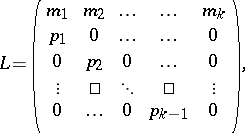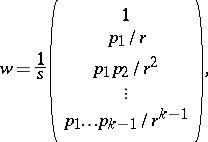Leslie matrix
Matrices arising in a discrete-time deterministic model of population growth [a3]. The Leslie model considers individuals of one sex in a population which is closed to migration. The maximum life span is  time units, and an individual is said to be in the
time units, and an individual is said to be in the  th age group if its exact age falls in the interval
th age group if its exact age falls in the interval  , for some
, for some  . The corresponding Leslie matrix is given by
. The corresponding Leslie matrix is given by
 |
where for each  ,
,  is the proportion of individuals in the
is the proportion of individuals in the  th age group who survive one time unit (this is assumed to be positive), and for each
th age group who survive one time unit (this is assumed to be positive), and for each  ,
,  is the average number of individuals produced in one time unit by a member of the
is the average number of individuals produced in one time unit by a member of the  th age group. Let
th age group. Let  be the average number of individuals in the
be the average number of individuals in the  th age group at time
th age group at time  units, and let
units, and let  be the vector
be the vector
 |
Then  , and since the conditions of mortality and fertility are assumed to persist,
, and since the conditions of mortality and fertility are assumed to persist,  for each integer
for each integer  .
.
If some  is positive, then
is positive, then  has one positive eigen value
has one positive eigen value  which is a simple root of the characteristic polynomial. For any eigenvalue
which is a simple root of the characteristic polynomial. For any eigenvalue  of
of  ,
,  ; indeed
; indeed  has exactly
has exactly  eigenvalues of modulus
eigenvalues of modulus  , where
, where  is the greatest common divisor of
is the greatest common divisor of  . Corresponding to the eigenvalue
. Corresponding to the eigenvalue  is the right eigenvector
is the right eigenvector  given by the formula
given by the formula
 |
where  . A left eigenvector corresponding to
. A left eigenvector corresponding to  has the form
has the form  , where for
, where for  ,
,
 |
The quantity  is interpreted as the reproductive value of an individual in the
is interpreted as the reproductive value of an individual in the  th age group.
th age group.
Suppose that there are indices  ,
,  such that
such that  , and both
, and both  and
and  are positive. If
are positive. If  , the sequence of age-distribution vectors,
, the sequence of age-distribution vectors,  , is asymptotically periodic as
, is asymptotically periodic as  , and the period is a divisor of
, and the period is a divisor of  depending on
depending on  . When
. When  , then as
, then as  , the sequence of age-distribution vectors converges to the eigenvector
, the sequence of age-distribution vectors converges to the eigenvector  , which is called the asymptotic stable age distribution for the population. The nature of the convergence of the age distributions is governed by the quantities
, which is called the asymptotic stable age distribution for the population. The nature of the convergence of the age distributions is governed by the quantities  , where
, where  is an eigenvalue of
is an eigenvalue of  distinct from
distinct from  ; a containment region in the complex plane for these quantities has been characterized (cf. [a2], [a5]). The sequence of vectors
; a containment region in the complex plane for these quantities has been characterized (cf. [a2], [a5]). The sequence of vectors  is asymptotic to
is asymptotic to  , where
, where  is a positive constant depending on
is a positive constant depending on  ; hence
; hence  is sometimes called the rate of increase for the population. The sensitivity of
is sometimes called the rate of increase for the population. The sensitivity of  to changes in
to changes in  is discussed in [a1] and [a6].
is discussed in [a1] and [a6].
Variations on the Leslie model include matrix models for populations classified by criteria other than age (see [a1]), and a model involving a sequence of Leslie matrices changing over time (see [a4] and [a6]). A stochastic version of the Leslie model yields a convergence result for the sequence  under the hypotheses that
under the hypotheses that  and
and  (see [a6]).
(see [a6]).
References
| [a1] | H. Caswell, "Matrix population models" , Sinauer (1989) |
| [a2] | K.P. Hadeler, G. Meinardus, "On the roots of Cauchy polynomials" Linear Alg. & Its Appl. , 38 (1981) pp. 81–102 |
| [a3] | P.H. Leslie, "On the use of matrices in certain population mathematics" Biometrika , 33 (1945) pp. 213–245 |
| [a4] | N. Keyfitz, "Introduction to the mathematics of population" , Addison-Wesley (1977) |
| [a5] | S. Kirkland, "An eigenvalue region for Leslie matrices" SIAM J. Matrix Anal. Appl. , 13 (1992) pp. 507–529 |
| [a6] | J.H. Pollard, "Mathematical models for the growth of human populations" , Cambridge Univ. Press (1973) |
Leslie matrix. Encyclopedia of Mathematics. URL: http://encyclopediaofmath.org/index.php?title=Leslie_matrix&oldid=14442